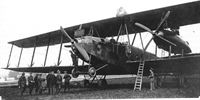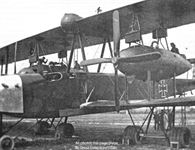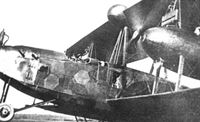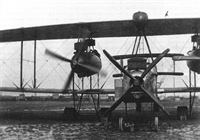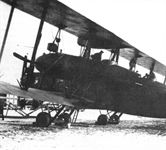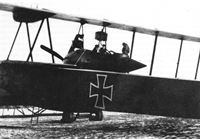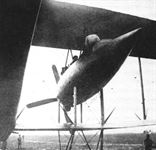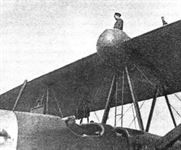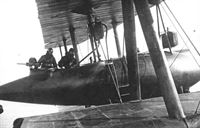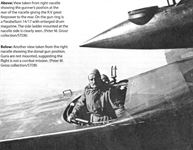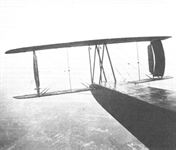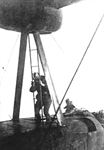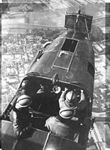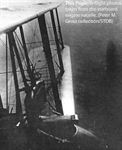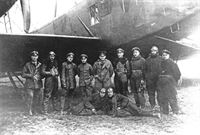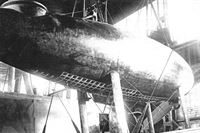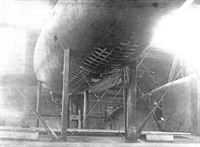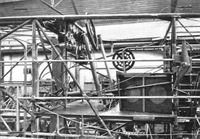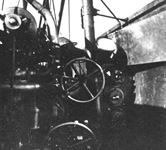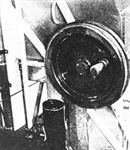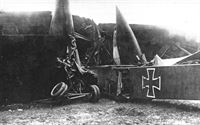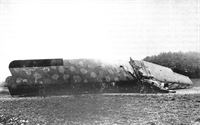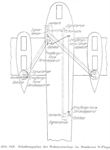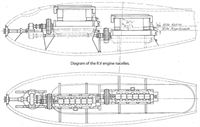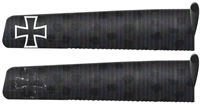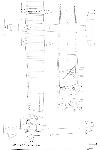
Описание
Страна: Германия
Год: 1916
Варианты
- Zeppelin-Staaken - VGO.I/VGO.II - 1915 - Германия
- Zeppelin-Staaken - R.V - 1916 - Германия
- Zeppelin-Staaken - VGO.III / R.IV / R.VII - 1916 - Германия
- В.Кондратьев Самолеты первой мировой войны
- O.Thetford, P.Gray German Aircraft of the First World War (Putnam)
- G.Haddow, P.Grosz The German Giants (Putnam)
- J.Herris Zeppelin-Staaken Aircraft of WW1. Vol 1: VGO.1 - R.IV R.29/16 (A Centennial Perspective on Great War Airplanes 47)
-
J.Herris - Zeppelin-Staaken Aircraft of WW1. Vol 1: VGO.1 - R.IV R.29/16 /Centennial Perspective/ (47)
Staaken R.V R.13/15 in early camouflage.
-
J.Herris - Zeppelin-Staaken Aircraft of WW1. Vol 1: VGO.1 - R.IV R.29/16 /Centennial Perspective/ (47)
Staaken R.V R.13/15 in late camouflage.
-
В.Обухович, А.Никифоров - Самолеты Первой Мировой войны
Цеппелин-Штаакен R V
-
J.Herris - Zeppelin-Staaken Aircraft of WW1. Vol 1: VGO.1 - R.IV R.29/16 /Centennial Perspective/ (47)
The R.V crew pre-flighting the aircraft for the next night combat mission. On the wing, near the cabin is standing 1st pilot Vizefeldwebel Heinrich Schmitz. May 1918 Schweldewindeke airfield. Note the 'Swallow nest' gun ring mounted at upper wing fuel tank. This mount is a German copy of British Scarf ring. The R.V is fully camouflaged for night operations. According to intelligence reports the day-time camouflage was over-painted by a matt blue lacquer mixture, with dark Prussian blue and ultramarine pigment. (Peter M. Grosz collection/STDB)
-
J.Herris - Weird Wings of WWI /Centennial Perspective/ (70)
"Цеппелин-Штаакен" R-V
The Staaken R.V differed from its predecessors in its engine arrangement; the nacelle engines were mounted as tractors. Power was from five 245 hp Maybach Mb.IVa engines, one in the nose and two in each engine nacelle geared together to drive the propeller. Fitting flexible machine guns in the rear of the nacelles gave the R.V very heavy firepower to the rear. Here it is seen with dark night bomber camouflage. The aircraft, military serial R.13/15, completed 18 combat missions such as bombing London, Calais, Dunkirk, Ostende, Ypres, Abbeville, St. Omer, Dieppe, and Rouen. (Peter M. Grosz collection/STDB) -
J.Herris - Zeppelin-Staaken Aircraft of WW1. Vol 1: VGO.1 - R.IV R.29/16 /Centennial Perspective/ (47)
Close-up of R.13 showing details.
-
J.Herris - Zeppelin-Staaken Aircraft of WW1. Vol 1: VGO.1 - R.IV R.29/16 /Centennial Perspective/ (47)
Photo taken shortly after the propeller was changed from two-bladed to four-bladed Garuda.The small spinner is not yet mounted. The small oil radiator is visible at the bottom of the nacelle. Here was cooling oil for both engines and the gear box which drove the Garuda aircrew. Two Hans Window radiators are mounted on the nacelle struts. The front engine is mounted lower and the rear is higher. (Peter M. Grosz collection/STDB)
-
J.Herris - Zeppelin-Staaken Aircraft of WW1. Vol 1: VGO.1 - R.IV R.29/16 /Centennial Perspective/ (47)
Close-up of the R.V showing the 'swallow's nest' gun nacelle in the upper wing. (Peter M. Grosz collection/STDB)
-
J.Herris - Zeppelin-Staaken Aircraft of WW1. Vol 1: VGO.1 - R.IV R.29/16 /Centennial Perspective/ (47)
R.13 warming up all engines, before take-off. The whole aircraft is painted with hexagonal night camouflage. Colors were very probably: green, dark ruby, Prussian blue and yellow, over-painted by matt dark blue lacquer. (Peter M. Grosz collection/STDB)
-
J.Herris - Zeppelin-Staaken Aircraft of WW1. Vol 1: VGO.1 - R.IV R.29/16 /Centennial Perspective/ (47)
Staaken R.V 13/15. The engines are being tested in preparation for a night mission from Scheldewindeke in 1918. At this time all propellers had two blades; later the nacelle propellers had four blades. (Peter M. Grosz collection/STDB)
-
J.Herris - Zeppelin-Staaken Aircraft of WW1. Vol 1: VGO.1 - R.IV R.29/16 /Centennial Perspective/ (47)
The R.13 with all propellers fitted with four blades. (Peter M. Grosz collection/STDB)
-
J.Herris - Zeppelin-Staaken Aircraft of WW1. Vol 1: VGO.1 - R.IV R.29/16 /Centennial Perspective/ (47)
The R.13 during preparation for its next night combat mission. (Peter M. Grosz collection/ STDB)
-
J.Herris - Zeppelin-Staaken Aircraft of WW1. Vol 1: VGO.1 - R.IV R.29/16 /Centennial Perspective/ (47)
The R.13 during continued preparation for its next night combat mission. (Peter M. Grosz collection/ STDB)
-
J.Herris - Zeppelin-Staaken Aircraft of WW1. Vol 1: VGO.1 - R.IV R.29/16 /Centennial Perspective/ (47)
The massive R.V being readied for another mission. (Peter M. Grosz collection/STDB)
-
J.Herris - Zeppelin-Staaken Aircraft of WW1. Vol 1: VGO.1 - R.IV R.29/16 /Centennial Perspective/ (47)
Flight engineer in his gunner's position.
-
J.Herris - Zeppelin-Staaken Aircraft of WW1. Vol 1: VGO.1 - R.IV R.29/16 /Centennial Perspective/ (47)
Crewman in the 'swallow's nest'. This had a flexible machine gun with 360° field of fire above the wing.
-
J.Herris - Zeppelin-Staaken Aircraft of WW1. Vol 1: VGO.1 - R.IV R.29/16 /Centennial Perspective/ (47)
View taken from right nacelle showing the gunner's position at the rear of the nacelle giving the R.V great firepower to the rear. On the gun ring is a Parabellum 14/17 with enlarged drum magazine. The side ladder mounted at the nacelle side is clearly seen. (Peter M. Grosz collection/STDB)
-
J.Herris - Zeppelin-Staaken Aircraft of WW1. Vol 1: VGO.1 - R.IV R.29/16 /Centennial Perspective/ (47)
In-flight photos taken from the starboard engine nacelle. (Peter M. Grosz collection/STDB)
-
J.Herris - Zeppelin-Staaken Aircraft of WW1. Vol 1: VGO.1 - R.IV R.29/16 /Centennial Perspective/ (47)
Another view taken from the right nacelle showing the dorsal gun position. Guns are not mounted, suggesting the flight is not a combat mission. (Peter M. Grosz collection/STDB)
-
J.Herris - Zeppelin-Staaken Aircraft of WW1. Vol 1: VGO.1 - R.IV R.29/16 /Centennial Perspective/ (47)
In-flight view taken from the right nacelle gunner position showing the characteristic Staaken tail unit on the R.V. The third rudder was never added to this (Staaken R.13) aircraft. (Peter M. Grosz collection/STDB)
-
J.Herris - Zeppelin-Staaken Aircraft of WW1. Vol 1: VGO.1 - R.IV R.29/16 /Centennial Perspective/ (47)
In-flight photos taken from the starboard engine nacelle. (Peter M. Grosz collection/STDB)
-
J.Herris - Zeppelin-Staaken Aircraft of WW1. Vol 1: VGO.1 - R.IV R.29/16 /Centennial Perspective/ (47)
THE ZEPPELIN GIANT AEROPLANE. - Looking down from the machine gunner's nest at the two pilots, the observer, and the commander.
View taken from the 'swallow's nest' of the pilots cockpit and front engine room. Ghent, Belgium is seen in the background. In the cabin are pilots Schmitz and Roeder and behind them is Lt. Pickerott, the aircraft commander, and Reichardt. (Peter M. Grosz collection/ STDB) -
J.Herris - Zeppelin-Staaken Aircraft of WW1. Vol 1: VGO.1 - R.IV R.29/16 /Centennial Perspective/ (47)
View aft from the "swallows nest" on the R.V.
-
J.Herris - Zeppelin-Staaken Aircraft of WW1. Vol 1: VGO.1 - R.IV R.29/16 /Centennial Perspective/ (47)
The Staaken R.V and its eleven crew photographed prior to its crash in October 1918. The aircraft commander Lt. Ernst Pickerott, first pilot Vizefeldwebel Heinrich Schmitz, second pilot Waldemar Roeder. Note the "Kathchen" Paulus Systeme parachute belts worn by some aviators. At this time, the R.V had eleven members: aircraft commander, two pilots, one observer officer, one flight engineer responsible for gasoline distribution, one radio operator, two mechanics, and three gunners. The crew strength varied from eight to 14 members according to the mission type. (Peter M. Grosz collection/STDB)
-
J.Herris - Zeppelin-Staaken Aircraft of WW1. Vol 1: VGO.1 - R.IV R.29/16 /Centennial Perspective/ (47)
Right nacelle photographed during maintenance. The bottom panels are removed and the inner wood frames of the nacelle structure are clearly seen. The brush-painted matt dark blue colored lacquer application is visible. (Peter M. Grosz collection/STDB)
-
J.Herris - Zeppelin-Staaken Aircraft of WW1. Vol 1: VGO.1 - R.IV R.29/16 /Centennial Perspective/ (47)
Nacelle during aircraft maintenance. The nacelle construction can be seen under the dismounted bottom panels. At the lower wing root is a four-bladed wind propeller powering the fuel pump. (Peter M. Grosz collection/STDB)
-
J.Herris - Zeppelin-Staaken Aircraft of WW1. Vol 1: VGO.1 - R.IV R.29/16 /Centennial Perspective/ (47)
R.V cockpit under construction.
-
J.Herris - Zeppelin-Staaken Aircraft of WW1. Vol 1: VGO.1 - R.IV R.29/16 /Centennial Perspective/ (47)
In-flight view of the inside of the engine nacelle. (Peter M. Grosz collection/STDB)
-
J.Herris - Zeppelin-Staaken Aircraft of WW1. Vol 1: VGO.1 - R.IV R.29/16 /Centennial Perspective/ (47)
Antenna wheel located at the radio operator's position. (Peter M. Grosz collection/STDB)
-
J.Herris - Zeppelin-Staaken Aircraft of WW1. Vol 1: VGO.1 - R.IV R.29/16 /Centennial Perspective/ (47)
The wreck of Zeppelin Staaken R.V (R.13/15) that crashed near Heistern, 3 October 1918 (18 October in other sources). After flying in heavy rain and fog all engines started to run badly and the new aircraft commander ordered the pilots to make an emergency landing. This was against their better judgment and the results showed why; the R.V was basically destroyed in the landing. Fourteen crew members and passengers were fortunate; only one person (Lt. Pickerott, the aircraft commander) was injured. Note the Balken cross painted at rudder. (Peter M. Grosz collection/ STDB)
-
J.Herris - Zeppelin-Staaken Aircraft of WW1. Vol 1: VGO.1 - R.IV R.29/16 /Centennial Perspective/ (47)
Another view of the crashed R.V. The fuselage cross shows were the old cross was scraped off and the new cross was painted on. Note the partially opened, nacelle gunner's parachute (probably a Kathchen Paulus Systeme) laying along the right nacelle. From 1917 the Rfa unit started to mount and test parachutes from two Systeme. First: Kathchen Paulus. The life saving parachute (Rettungsfallschirm) type"K. P." primary was used at early LZ, SL, and PL type Airships and observation balloons. Second: The Heinecke parachute system, designed for fighters and two-seater aircraft. Finally after tests the system Heinecke was chosen for Riesenflugze. But probably from an insufficient supply of parachutes, both types were used. (Peter M. Grosz collection/STDB)
-
J.Herris - Zeppelin-Staaken Aircraft of WW1. Vol 1: VGO.1 - R.IV R.29/16 /Centennial Perspective/ (47)
View of the upper wing of the crashed R.V (R.13/15) bomber. Note the night camouflage (dark blue color) overpainted the lozenge pattern and the scraped crosses. The lozenges on the wing undersides are brighter than on the fuselage and upper side so must be not darkened by dark bluish lacquer. (Peter M. Grosz collection/STDB)
-
J.Herris - Zeppelin-Staaken Aircraft of WW1. Vol 1: VGO.1 - R.IV R.29/16 /Centennial Perspective/ (47)
Pneumatic tube system in Staaken R-planes.
-
J.Herris - Zeppelin-Staaken Aircraft of WW1. Vol 1: VGO.1 - R.IV R.29/16 /Centennial Perspective/ (47)
Diagram of the R.V engine nacelles.
-
J.Herris - Zeppelin-Staaken Aircraft of WW1. Vol 1: VGO.1 - R.IV R.29/16 /Centennial Perspective/ (47)
Staaken R.V R.13/15 early & late camouflage.
-
В.Кондратьев - Самолеты первой мировой войны
"Цеппелин-Штаакен" R-V
-
G.Haddow, P.Grosz - The German Giants /Putnam/
Staaken R.V
В.Кондратьев Самолеты первой мировой войны
МОДИФИКАЦИИ
"Цеппелин-Штаакен" R-V и R-VII. Первый опыт воздушных боев показал, что истребители почти всегда атакуют бомбардировщики с задней полусферы. Поэтому, для более эффективной защиты, на очередной модификации "Цеппелина" мотогондолы как бы развернули на 180 градусов.
Двигатели с винтами установили спереди, а турели - сзади. Кроме того, на R-V еще одну турель с практически неограниченным полем обстрела смонтировали в так называемом "ласточкином гнезде" над верхним крылом, куда при угрозе нападения стрелок поднимался по лестнице.
Четырехлопастные винты на R-V приводились в движение пятью моторами "Майбах" Mb.IV по 240 л.с. (1 в носу и 2 спарки в гондолах). В фюзеляже R-VII стояли 2 "Мерседеса" по 160 л.с., а в гондолах - 4 "Бенца" по 220 л.с. Обе машины в 1917 году отправили на западный фронт. R-VII разбился по дороге, а R-V некоторое время использовался в качестве ночного бомбардировщика.
Описание:





